| TSP Lab
| Sga-7N-4 - ISUP CDR lister
| Sga-7N-4
|
ISUP CDR lister module
("Sga-7N-4")
Table of Contents
Features
- Queries Call Data Records ("CDR") for a given time interval from the CDR database
created by the ISUP CDR Generator
- Can filter for
- Destination and/or Originating Point Code (DPC, OPC),
- Circuit Identification Code (CIC)
- A, B, C, or D number and Nature of Address
- Release cause
- Transit Network Selection
- Multiple Release Cause values (at most 10) can be set for filtering, with optional inversion.
- Four Release Cause value groups (profiles) can be saved and reloaded.
- The result list may contain operator's name beside the subscribers' numbers
- In the result list the PointCodes of IP based LAPD messages are shown as 'DSS1',
and the PointCodes of SS7 based LAPD messages are shown as 'DSS1(n)'. (Value of 'n' is set in the monitor units.)
- Output is a 'comma separated value' (csv) format
- If file association is made output can be opened directly from the lister module
The user interface
The ISUP CDR Lister module can be started by double clicking on its icon (as usual in Windows environment).
First the User Authentication window appears where it is needed to type a username and the password for this username.
In addition it must also give a reason why the user wants to use this module.
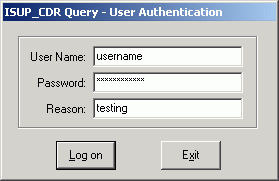
After the successful authentication the main window appears:
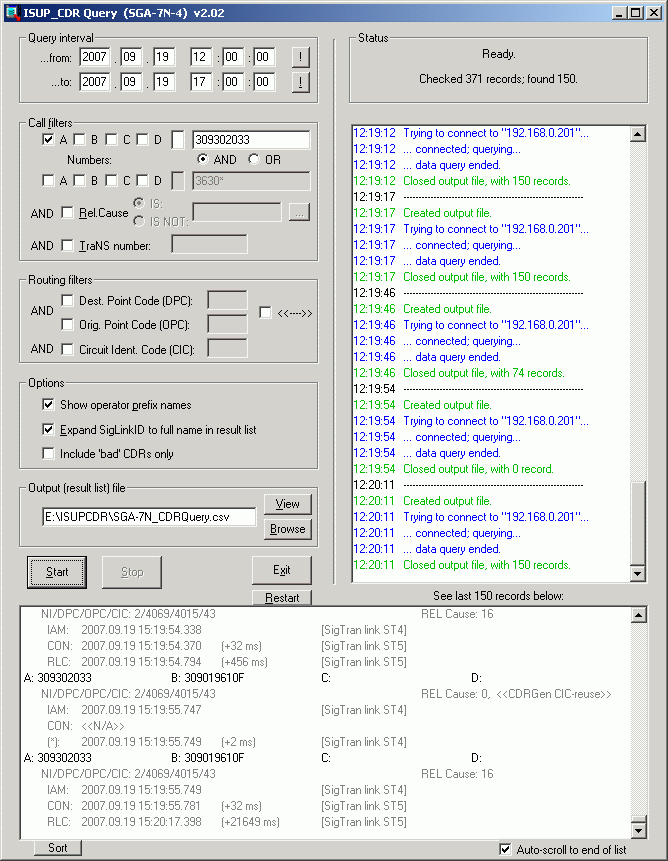
Details of the main window
- Query interval
- CDR's are queried which timestamp is between ...from and ...to value
- !: this button fills the time fields with the actual date and time
- Call filters
- Two numbers can be given for searching, they can be full or partial numbers (part of the number + '*', e.g. '36*')
- The numbers can be A (Calling party number) or B (Called party number) or C (Original call number)
or D number (Redirecting call number) (if more than one is checked they are in 'OR' relation)
and the Nature-of-Address parameter also can be set
- If two numbers are given relation between them must be selected ('OR' or 'AND')
- Prefix names can also be given amongst the call filters. For this feature NoA fields accept 'x' character as well
to indicate prefix name in the call filter number field. Background of NoA field becomes red if its contents is invalid
and background of the number fields become yellow when they expect prefix name instead of an MSISDN.
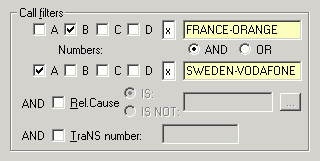
- Rel.Cause: Further condition can be set based on the release cause codes.
When the ... button is pressed a new window appears where a group of release cause codes can be selected
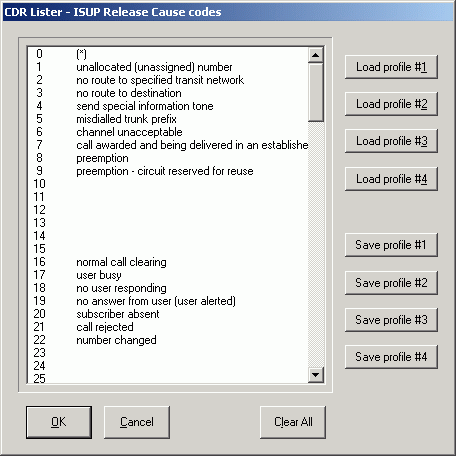
- ISUP Release Cause Codes
- Clear All: all selected elements will be deselected
- Save Profile#N: there is a possibility to save four different selections of the release cause codes
- Load Profile#N: saved selections can be loaded with these buttons
- TraNS number: it is possible to search calls where the Transmission Network Selection parameter is the given
- Routing filters
- Destination Point Code (DPC): only CDRs to this destination will be selected
- Originating Point Code (OPC): only CDRs from this Point Code will be selected
- <<...>>: if it is checked the given point codes can be DPC or OPC as well
- Circuit Identifier Code (CIC): only calls on this circuit will be listed
- Options
- Show operator prefix names: operators prefix names will be listed in the result list beside the subscribers' MSISDN
- Expand SigLinkID to full name in result list: the result list will contain the full SigLinkName instead of the short SigLinkID
- Include bad CDRs only: Records missing one or more ISUP message (because it has not been seen by the monitor)
or with 'negative duration' (disordered messages) can be listed by this option
- Output (result list) file
- View: with this button the result can be viewed if the selected file type is associated with the proper application to open
- Browse: the result file can be selected (if this is an existing file) by browsing the local file system
- Start
- Start the querying, creates output CDR list file
- Stop
- Exit
- Restart
- stops and starts again the CDR Lister module with four options
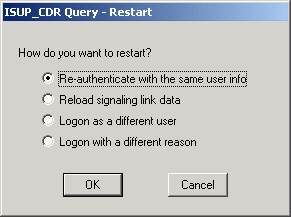
- Re-authenticate with the same user info: Restarts the module and logs in with
the same username/password/reason values
- Reload signalling link data: without restart it request again the SL.dat information
(for example when information was changed at the server)
- Logon as a different user: Logs out and gives the authentication window again to log in with a new user
- Logon with a different reason: Gives the authentication window to type the new reason for logging on
- Result list box
- Some parameters of CDR's fit for the searching criteria are listed here (they can be copied to the Clipboard)
- the A and B and C and D numbers
- NI/DPC/OPC/CIC values
- ReleaseCause values
- Timestamp and SignalingLink of IAM
- CON/ANM time since IAM and its SignalingLink
- RLC time since IAM and its SignalingLink
- Sort
- Lines up calls in the result list box based on timestamp of the initial message (IAM)
- double-clicking on a records in this list opens RemoteCapture module with the proper parameters to acquire the MSU's of this call
- Auto-scroll to end of list
- When it is checked the log book scrolls to the end of the list
- Status
- indicates the checking and searching status during the process
- Log box
- screen log about the operation (it can be copied to the Clipboard)
Auto hide feature
When the user is not active (no mouse movement and keyboard stroke) for a given amount of time
(for example 10 minutes) then the module's result list box goes hidden and a user verification field appears.
The user has to enter the password in order to be able to see result list box again.
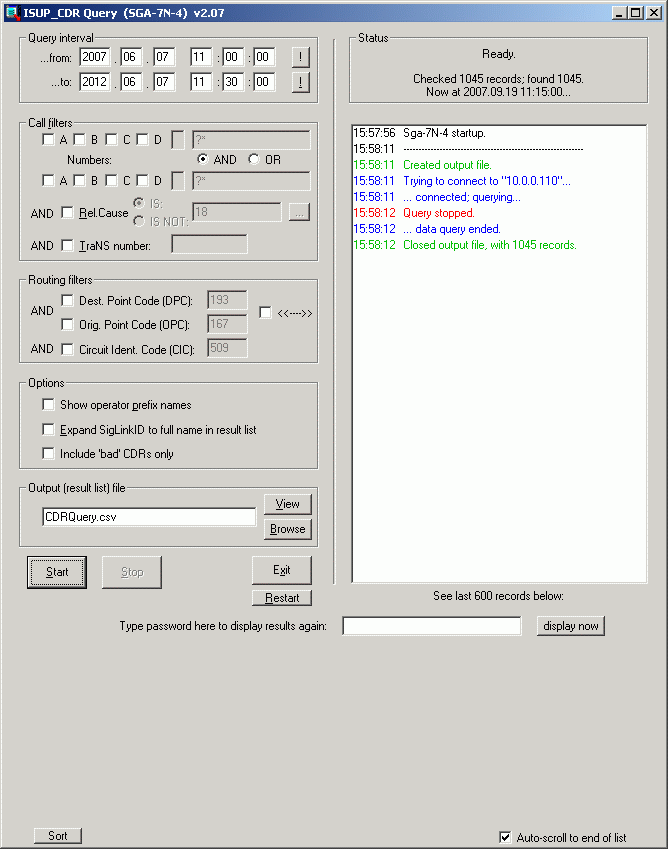
Auto logout feature
When there is no active remote capture request in progress for a given amount of time (for example 60 minutes)
then the module automatically logs the user out. In that case the following pop-up window appears.

Result list format
Format and content of output file
The output file is a "Comma separated values" file which contains the list of the results of searching.
Each row contains data of one single call. Values and their interpretations are the followings.
- Date & time: timestamp of the "Initial address" message (IAM)
- NI/DPC/OPC/CIC: parameters from "Initial address" message (IAM)
- IAM-ANM [ms]: duration between "Initial address" (IAM) and "Answer" messages
- IAM-REL [ms]: duration between "Initial address" (IAM) and "Release" (REL) messages
- TraMR: "Transmission medium requirement" parameter from the "Initial address" message (IAM).
For further details, refer to "3.54 Transmission medium requirement" subcaluse of ITU Q.763.
- UseSI: First byte of the "User service information" parameter of the "Initial address" message (IAM).
Its lower 5 bits and the next 2 bits represent the "Information transfer capability" and the "Coding standard" fields, respectively.
For further details, refer to "3.57 User service information" subclause of ITU Q.763 and "4.5.5 Bearer capability" subclause of ITU Q.931.
- NoA/CagPN(A)/op.pref: "Nature of address indicator"/"Address signal" elements of "Calling party number" parameter from the "Initial address" message (IAM).
In case Show operator prefix names option is checked on user interface then operator name is also indicated next to the "Address signal".
- NoA/CadPN(B)/op.pref: "Nature of address indicator"/"Address signal" elements of "Called party number" parameter from the "Initial address" message (IAM).
In case Show operator prefix names option is checked on user interface then operator name is also indicated next to the "Address signal".
- NoA/OriCN(C)/op.pref: "Nature of address indicator"/"Address signal" elements of "Original called number" parameter from the "Initial address" message (IAM).
In case Show operator prefix names option is checked on user interface then operator name is also indicated next to the "Address signal".
- NoA/RedGN(D)/op.pref: "Nature of address indicator"/"Address signal" elements of "Redirecting number" parameter from the "Initial address" message (IAM).
In case Show operator prefix names option is checked on user interface then operator name is also indicated next to the "Address signal".
- TraNS: "Transit network selection" parameter from the "Initial address" message (IAM)
For further details, refer to "3.53 Transit network selection" subcaluse of ITU Q.763.
- RelCause: "Cause value" element of "Cause indicators" parameter from the "Release" message (REL).
For further details, refer to "3.12 Cause indicators" subclause of ITU Q.763 and "Cause information element" table of ITU Q.850.
- IAM SigLink/dir: SigLinkID where the "Initial address" message (IAM) was seen
(SigLink ID or full name when Expand SigLinkID to full name in result list checkbox is set)
- ACM SigLink/dir: SigLinkID where the "Address complete" message (IAM) was seen
(SigLink ID or full name when Expand SigLinkID to full name in result list checkbox is set)
- Direction of ACM correlate to IAM: "==" in case of same, "<>" in case of reverse direction
- ANM SigLink/dir: SigLinkID where the "Answer" message (ANM) was seen
(SigLink ID or full name when Expand SigLinkID to full name in result list checkbox is set)
- Direction of ANM correlate to IAM: "==" in case of same, "<>" in case of reverse direction
- REL SigLink/dir: SigLinkID where the "Release" message (REL) was seen
(SigLink ID or full name when Expand SigLinkID to full name in result list checkbox is set)
- Direction of REL correlate to IAM: "==" in case of same, "<>" in case of reverse direction
- RLC SigLink/dir: SigLinkID where the "Release complete" message (RLC) was seen
(SigLink ID or full name when Expand SigLinkID to full name in result list checkbox is set)
- Direction of RLC correlate to IAM: "==" in case of same, "<>" in case of reverse direction
- Remark(s): comments for the CDR
- Reuse: a new IAM has arrived with the same CIC while another call on that CIC was in progress
- Shut Down: the CDR generator has closed the CDR because it was shut down
- TimeOut: the call has been longer than Sga7N_ISUP_CDRGen.ini/[Advanced]/dwActiveCallDurationTimeOutSec
- FakeIAM: if an IAM is missing a FakeIAM will be created and indicated by this remark
Configuration (Sga-7N-4.ini) file settings
The configuration file is placed in the C:\WinNT or the C:\Windows directory.
| Section
| Entry
| Example
| Meaning
|
| [Settings]
|
|
| In this section parameters and settings from the user interface are stored for the next usage.
|
| [Advanced]
|
|
|
|
|
| sSGA7N3Path
| c:\Sga-7N Client
| Path of RemoteCapture module (for the easy getting of MSU's)
|
|
| sPollerIPAddress
| 111.22.33.44
| The server IP address where the authentication server module is running
(Typically it is the same where the Poller module is running)
|
Version history
v2.19
- (c) Can handle 9000 signaling links at most.
v2.12
- (c) Length of a password can be at most 31 characters.
v2.11
- (f) Absolute timestamps in the result window were incorrect in some cases. (However the relative timestamps and the output file were correct every time.)
v2.10
- (c) Can handle 5000 signaling links at most (instead of the former limit of 3000).
v2.09
- (c) Module is restored if iconized when inactivity time-out expires.
v2.08
- (c) When "byInactiveUserDimTime" expires every control on user interface is disabled.
v2.07
- (n) Auto-hide feature for the result window to fulfill security regulations.
- (n) Auto-LogMeOut feature to fulfill security regulations.
- (n) Logs query results.
v2.06
- (f) Absolute and relative timestamps were displayed incorrectly when an earlier RLC (or ANM/CON) was assigned to an IAM.
v2.05
- (n) DSS1-specific headings in output CSV file as well as in the result window.
- (c) DSS1-specific handling of point codes when passing data to Remote Capture module.
v2.04
- (c) PointCodes are shown as 'DSS1' instead of 0x3FF, and 'DSS1(n)' instead of 0x300+n.
v2.03
- (f) Query result window data was corrupted if a CSV output line was too long
(could usually happen with 'Show operator prefix names' switched on).
v2.02
- (n) Indicates CDR information (if available) about the (PC-based) direction of the ACM, ANM, REL, and RLC MSU's,
compared to that of the IAM MSU.
v2.01
- (c) Result lines are shown with full link names.
- (f) NI bits are masked out when invoking RemoteCapture (to pass DPC and OPC correctly).
- (c) Looks good also with legacy screen resolutions (1024x768).
v2.00
- (c) Major redesign for GyDB-operability.
- (n) Selected output file is checked; overwrite prompt is given if already existed.
- (n) New input fields for queries: Number1/NoA, Number2/NoA, Number1/D, Number2/D, and TraNS number.
- (n) New input options for queries: ShowOperatorPrefixNames, ExpandSiglinkName, and IncludeBadCDRsOnly.
- (c) Output file format is CSV, with many more ISUP fields.
- (n) New INI entries in the [Settings] section: sNumber1NoA, sNumber2NoA, bNumber1DSet, bNumber2DSet, bTraNSNumberSet,
sTraNSNumberValue, sCSVFileNameOut, bShowOperatorPrefixNames, bIncludeBadCDRsOnly, and bExpandSiglinkName.
- (c) Obsolete INI entries in the [Settings] section: bContinuousQuery, bEnableSaveToFile, and sFileName.
- (c) Obsolete INI entry in the [Advanced] section: sHostString.
v1.27
- (n) Multi-line selection log window, with copy-to-clipboard functionality.
- (n) Shift-ESC combination minimizes application window.
v1.26
- (n) Multiple Release Cause values (at most 10) can be set for filtering, with optional inversion.
- (n) Listbox for Release Cause value selection with codes and names.
- (n) Four Release Cause value groups (profiles) can be saved and reloaded.
- (n) INI/[Settings]/bRelCauseIsNot and sRelCauses
- (n) INI/[MultiRelCauProfiles]sRelCauseProfile #1, #2, #3, and #4
- (c) INI/[Settings]/dwRelCause is no longer used.
v1.25
- (c) Handled in Sga-Authorizer with application ID 7014; used to be 7004.
v1.24
- (n) Requires a "Reason" be given at authentication.
v1.23
- (n) INI/[Advanced]/sHostString (defaults to "sga7n.nis.westel900.hu", used to be hard-wired as "sga7n").
- (c) Requires Sga7NDb2.dll v1.11.







